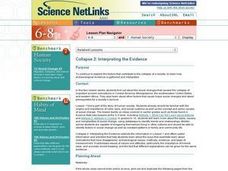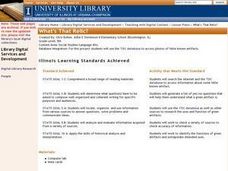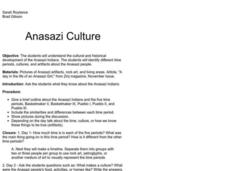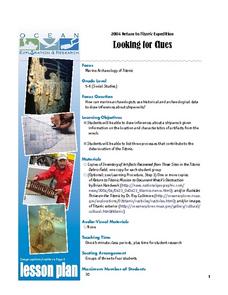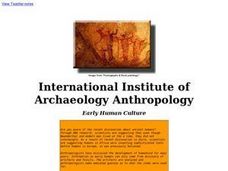Curated OER
Spice It Up!
Students analyze visual artifacts from Asian descent and follow the path of famous explorers on the Silk Road. In this Asian artifacts lesson plan, students use their senses to explore and grind spices using a mortar and pestle.
Curated OER
Science NetLinks: Collapse 2: Interpreting the Evidence
Students continue to explore the factors that contribute to the collapse of a society; they also explore how archaeological evidence is gathered and interpreted. Students explore about the social changes that caused the collapse of...
Curated OER
The Anasazi
Sixth graders investigate and determine the origins of the ancient Anasazi who inhabited present-day Utah and the Four-Corners-Region, after receiving direct instruction and carrying out activities in cooperative group settings. They...
Curated OER
Treasures Along the Silk Roads
Ninth graders examine the travels of the Silk road. In this Ancient China lesson plan, 9th graders analyze slides of artifacts as cultural and social representations of the Silk Road civilizations. Students create a word map...
Curated OER
Show Me a Flowerpot
Students compare and contrast handmade and machine-made products in a study about the evolution of production processes in American history. In this production history lesson plan, students explore a flowerpot in depth. Students make...
Curated OER
Treasures of the Silk Roads
Young scholars examine and discuss art objects from the Silk Roads. They analyze images of artifacts, create a word map, and develop and write a short story or poem based on the slides viewed.
Curated OER
What's That Relic?
Fifth graders listen to a read aloud of David Mc Cauley's book Motel of the Mysteries. They discuss an unknown artifact and decide what it might be used for. They research other artifacts and play "What's that Relic?"
Curated OER
Anasazi Culture
Young scholars explain the cultural and historical development of the Anasazi Indians. They identify different time periods, cultures, and artifacts about the Anasazi people.
Curated OER
Introduction to Native Americans Thematic Unit
Students consider different cultural viewpoints. In this Native American history lesson, students examine artifacts and then conduct research on selected Native American tribes.
Curated OER
Lesson plan: Archaeology - Its Methods and Use
Students study the field of archeology. In this archeology lesson, students participate in 12 activities that require them to examine archeology, garbology, artifacts, ethical issues, and field specific vocabulary.
Curated OER
What's in the Soil?
Second graders create stratified soil levels using pictures. For this earth science lesson, 2nd graders identify "artifacts" from 3 historic eras and divide them into 3 soil levels. Then they draw their own multi-level soil profile and...
Curated OER
Ancient Egypt/Mummification/Preservation
Sixth graders identify characteristics of preserved artifact, distinguish between an example and non-example of a preserved artifact, and connect the definition of preserve to the Egyptian art of mummification.
Curated OER
Titanic: Looking for Clues
Students make inferences about a shipwreck based on the location of artifacts. They role play as marine archaeologists and list three processes that contribute to the deterioration of the Titanic.
Curated OER
Jamestown Fort: Finding History
Learners identify artifacts discovered from the exploration of the Jamestown fort in order to help them create a short fictional account about the lives of Jamestown's first inhabitants. In this history lesson plan, students research...
Curated OER
Shipwreck Mystery
Students study web pages on a shipwreck then locate where this took place on a map. In this marine archaeologist lesson plan students examine what clues archaeologists use to find the location of a shipwreck and what they...
Curated OER
Introduction of Primary Sources
First graders create two personal artifacts to add to a primary source shoebox that represents information about themselves. The first draw a self-portrait then build an artifact from Play-Doh and pipe cleaners to represent something...
Curated OER
Relative Dating in Archaeology
Students create a timeline that explains how ancient cultures used artifacts. In this Relative Dating in Archaeology lesson plan, students examine artifacts and draw conclusions about their origins. Then students analyze antiquated...
Curated OER
Lesson Plan: Touring The Alamo
Students discover the size of the Alamo and artifacts of the time period by navigating through a virtual tour of the Alamo.
Curated OER
International Institute of Archaeology an Anthropology
Students research early humans and their cultures. They conduct Internet research, discuss their findings with their group, evaluate the information provided by artifacts, and create a report to present to a simulated archaeology institute.
Curated OER
Chinese Immigration
Students identify artifacts from Chinese immigrants that are common to other immigrant groups, describe how American society discriminated against the Chinese, describe contribution of Chinese immigrants to American society, discuss two...
Curated OER
Japan: Yesterday and Today
Students study the geography and culture of Japan and discover important historical events. They look at the religions of Japan. They determine similarities and differences in the lives of teenagers in Japan and the US. They read and...
Curated OER
Independence Masks
Learners explore how art reflects the economic, political, social, religious and historical concerns of a culture. They research a former colony to determine if there is any history of a mask. Students create a mask representing the...
Curated OER
China's Ethnic Minorities
Third graders are introduced to various Chinese ethnic groups. They consider how geography affects ethnic groups and examine artifacts produced by Chinese peoples. They prepare a presentation of their research and artifact interpretation.
Curated OER
Scrapbook of Freedom
Third graders create a scrapbook using personal narratives and samples of artifacts to connect to maps of geographical locations of the Underground Rail Road. they describe at least one of the feelings a child slave might have had...



